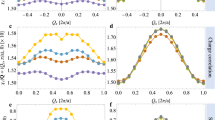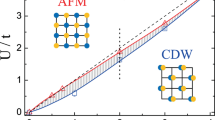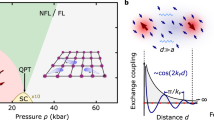Abstract
The recent discovery of two heavy-fermion materials PuCoGa5 and NpPd5Al2, which transform directly from Curie paramagnets into superconductors, reveals a new class of superconductors where local moments quench directly into the superconducting condensate. Unlike other heavy-electron superconductors, where Cooper pairing is thought to be driven by spin fluctuations, these higher-transition-temperature materials do not seem to be close to a magnetic instability. Large-N expansions have been invaluable in describing heavy-fermion metals, but so far cannot treat superconductivity. Here, we introduce a new class of large-N expansion that uses symplectic symmetry to protect the odd time-reversal parity of spin and sustain Cooper pairs as well-defined singlets. We show that when a lattice of magnetic ions exchange spin with their metallic environment in two distinct symmetry channels, they can simultaneously satisfy both channels by forming a condensate of composite pairs between local moments and electrons. In the tetragonal crystalline environment relevant to PuCoGa5 and NpPd5Al2, the lattice structure selects a natural pair of spin exchange channels, predicting a unique anisotropic paired state with either d- or g-wave symmetry. This pairing mechanism also predicts a large upturn in the NMR relaxation rate above Tc and strong enhancement of Andreev reflection in tunnelling measurements.
This is a preview of subscription content, access via your institution
Access options
Subscribe to this journal
Receive 12 print issues and online access
$209.00 per year
only $17.42 per issue
Buy this article
- Purchase on Springer Link
- Instant access to full article PDF
Prices may be subject to local taxes which are calculated during checkout



Similar content being viewed by others
References
Read, N. & Newns, D. M. A new functional integral formalism for the degenerate Anderson model. J. Phys. C 16, L1055–L1060 (1983).
Read, N. & Newns, D. M. On the solution of the Coqblin–Schrieffer Hamiltonian by the large-N expansion technique. J. Phys. C 16, 3273–3295 (1983).
Auerbach, A. & Levin, K. Kondo Bosons and the Kondo lattice: Microscopic basis for the heavy Fermi liquid. Phys. Rev. Lett. 57, 877–880 (1986).
Affleck, I. & Marston, J. B. Large-N limit of the Heisenberg–Hubbard model: Implications for high-Tc superconductors. Phys. Rev. B 37, 3774–3777 (1988).
Arovas, D. P. & Auerbach, A. Functional integral theories of low-dimensional quantum Heisenberg models. Phys. Rev. B 38, 316–332 (1988).
Sarrao, J. L. et al. Plutonium-based superconductivity with a transition temperature above 18 K. Nature 420, 297–299 (2002).
Aoki, D. et al. Unconventional heavy-Fermion superconductivity of a new transuranium compound NpPd5Al2 . J. Phys. Soc. Japan 76, 063701–063704 (2008).
Beal Monod, M. T., Bourbonnais, C. & Emery, V. Possible superconductivity in nearly antiferromagnetic itinerant fermion systems. Phys. Rev. B. 34, 7716–7720 (1986).
Miyake, K., Schmidt Rink, S. & Varma, C. M. Spin-fluctuation-mediated even-parity pairing in heavy-fermion superconductor. Phys. Rev. B 34, 6554–6556 (1986).
Scalapino, D. J., Loh, E. & Hirsch, J. E. d-wave pairing near a spin-density-wave instability. Phys. Rev. B 34, 8190–8192 (1986).
Mathur, N. et al. Magnetically mediated superconductivity in heavy fermion compounds. Nature 394, 39–43 (1998).
Monthoux, P. & Lonzarich, G. G. Magnetically mediated superconductivity in quasi-two and three dimensions. Phys. Rev. B 63, 054529–054538 (2001).
Monthoux, P. & Lonzarich, G. G. Magnetically mediated superconductivity: Crossover from cubic to tetragonal lattice. Phys. Rev. B 66, 224504–224511 (2002).
Tanaka, K., Ikeda, H. & Yamada, K. Theory of superconductivity in PuCoGa5 . J. Phys. Soc. Japan 73, 1285–1289 (2004).
Sakurai, J. J. Modern Quantum Mechanics Revised Edition 277 (Addison-Wesley, Reading, MA, 1994).
Read, N. & Sachdev, S. Large-N expansion for frustrated quantum antiferromagnets. Phys. Rev. Lett. 66, 1773–1776 (1991).
Sachdev, S. & Wang, Z. Pairing in two dimensions: A systematic approach.. Phys. Rev. B 43, 10229–10235 (1991).
Tchernyshyov, O., Moessner, R. & Sondhi, S. L. Flux expulsion and greedy bosons: Frustrated magnets at large-N. Europhys. Lett. 73, 278–284 (2006).
Sachdev, S. Kagomé- and triangular-lattice Heisenberg antiferromagnets: Ordering from quantum fluctuations and quantum-disordered ground states with unconfined bosonic spinons’. Phys. Rev. B 45, 12377–12396 (1992).
Vojta, M., Zhang, Y. & Sachdev, S. Competing orders and quantum criticality in doped antiferromagnets. Phys. Rev. B 62, 6721–6744 (2000).
Nickolić, P. & Sachdev, S. Renormalization-group fixed points, universal phase diagram, and 1/N expansion for quantum liquids with interactions near the unitarity limit. Phys. Rev. A 75, 033608–033621 (2007).
Veillette, M., Sheehy, D. & Radzihovsky, L. Large-N expansion for unitary superfluid Fermi gases. Phys. Rev. A 75, 043614–043636 (2007).
Wu, C. & Zhang, S. Sufficient condition for absence of the sign problem in the fermionic quantum Monte Carlo algorithm. Phys. Rev. B 71, 155115–155128 (2005).
Affleck, I., Zou, Z., Hsu, T. & Anderson, P. W. SU(2) gauge symmetry of the large-U limit of the Hubbard model. Phys. Rev. B 38, 745–747 (1988).
Ceccatto, H. A., Gazza, C. J. & Trumper, A. E. Nonclassical disordered phase in the strong quantum limit of frustrated antiferromagnets. Phys. Rev. B 47, 12329–12332 (1993).
Cox, D. L. & Jarrell, M. The two-channel Kondo route to non-Fermi-liquid metals. J. Phys. Condens. Matter 8, 9825–9853 (1996).
Mark, J., Pang, H. & Cox, D. L. Phase diagram of the two-channel Kondo lattice. Phys. Rev. Lett. 78, 1996–2000 (1997).
Cox, D. L. & Zawadowski, A. Exotic Kondo effects in metals: Magnetic ions in a crystalline electric field and tunneling centers. Adv. Phys. 47, 599–942 (1998).
Coleman, P., Tsvelik, A. M., Andrei, N. & Kee, H. Y. Co-operative Kondo effect in the two-channel Kondo lattice. Phys. Rev. B 60, 3608–3628 (1999).
Ran, Y. & Wen, X. G. Detecting topological order through a continuous quantum phase transition. Phys. Rev. Lett. 96, 026802–026805 (2006).
Curro, N. J. et al. Unconventional superconductivity in PuCoGa5 . Nature 434, 622–625 (2005).
Blonder, G. E., Tinkham, M. & Klapwijk, T. M. Transition from metallic to tunneling regimes in superconducting microconstrictions: Excess current, charge imbalance, and supercurrent conversion. Phys. Rev. B 25, 4515–4532 (1982).
Kaminski, A., Nazarov, Yu. V. & Glazman, L. I. Suppression of the kondo effect in a quantum dot by external irradiation. Phys. Rev. Lett. 83, 384–387 (1999).
Park, W. K., Sarrao, J. L., Thompson, J. D. & Greene, L. H. Andreev reflection in heavy-Fermion superconductors and order parameter symmetry in CeCoIn5 . Phys. Rev. Lett. 100, 177001 (2008).
Wastin, F., Boulet, P., Rebizant, J., Colineau, E. & Lander, G. H. Advances in the preparation and characterization of transuranium systems. J. Phys. Condens. Matter 15, S2279–S2285 (2003).
Hegger, H. et al. Pressure-induced superconductivity in quasi-2D CeRhIn5 . Phys. Rev. Lett. 84, 4986–4989 (2000).
Petrovic, C. et al. A new heavy-fermion superconductor CeIrIn5: A relative of the cuprates? Europhys. Lett. 53, 354–359 (2001).
Petrovic, C. et al. Heavy-fermion superconductivity in CeCoIn5 at 2.3 K. J. Phys. Condens. Matter 13, L337–L342 (2001).
Christianson, A. D. et al. Crystalline electric field effects in CeMIn5: Superconductivity and the influence of Kondo spin fluctuations. Phys. Rev. B 70, 134505–134513 (2004).
Larkin, A. I. & Melnikov, V. I. Magnetic impurities in an almost magnetic metal. Sov. Phys. JETP 34, 656–661 (1972).
Maebashi, H., Miyake, K. & Varma, C. M. Undressing the Kondo effect near the antiferromagnetic quantum critical point. Phys. Rev. Lett. 95, 207207–207211 (2005).
Acknowledgements
This research was supported by the National Science Foundation grant DMR-0605935 and US Department of Energy grant DE-FE02 00ER45790 (M.D.). The authors would like to thank N. Andrei, K. Basu, E. Miranda, R. Moessner, P. Pagliuso, S. Sachdev, N. Read, G. Zarand and particularly S. Thomas, for discussions related to this work.
Author information
Authors and Affiliations
Corresponding author
Supplementary information
Supplementary Information
Supplementary Information and Supplementary Figures 1—4 (PDF 887 kb)
Rights and permissions
About this article
Cite this article
Flint, R., Dzero, M. & Coleman, P. Heavy electrons and the symplectic symmetry of spin. Nature Phys 4, 643–648 (2008). https://doi.org/10.1038/nphys1024
Received:
Accepted:
Published:
Issue Date:
DOI: https://doi.org/10.1038/nphys1024
This article is cited by
-
A holographic two-impurity Kondo model
Journal of High Energy Physics (2016)
-
Strong-coupling d-wave superconductivity in PuCoGa5 probed by point-contact spectroscopy
Nature Communications (2012)
-
Frustration and the Kondo Effect in Heavy Fermion Materials
Journal of Low Temperature Physics (2010)
-
Isotropic quantum scattering and unconventional superconductivity
Nature (2008)



